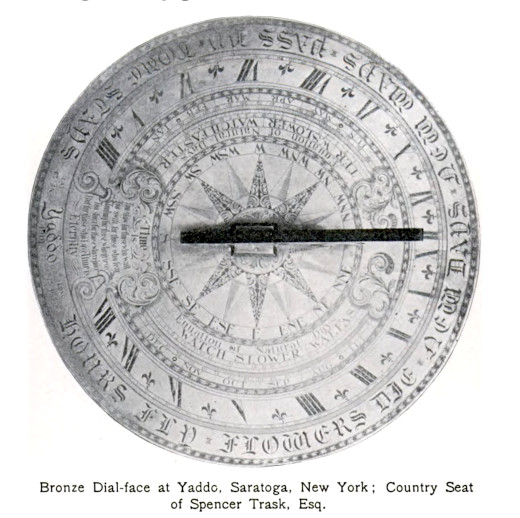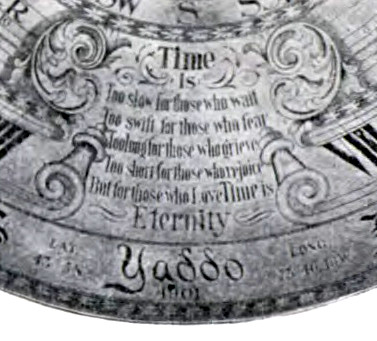William Shakespeare? Henry van Dyke? Alice Morse Earle? Katrina Trask? H. L. Mencken? Lady Jane Fellowes? Apocryphal?

Question for Quote Investigator: The following lines have been credited to the famous English playwright and poet William Shakespeare:
Time is very slow for those who wait
Very fast for those who are scared
Very long for those who lament
Very short for those who celebrate
But for those who love, time is eternal.
I haven’t been able to find a citation and I am skeptical of this attribution. Would you please explore this topic?
Reply from Quote Investigator: QI has found no substantive support for the ascription to William Shakespeare. QI conjectures these lines were derived from a sundial inscription crafted by the U.S. author and clergyman Henry van Dyke. Two separate poems by van Dyke appeared on the sundial, and both were recorded in a 1901 book by historian Alice Morse Earle titled “Old-Time Gardens Newly Set Forth”. Earle encountered the sundial in a rose garden at the Yaddo estate of Spencer and Katrina Trask in Saratoga Springs, New York. Boldface added to excerpts by QI:1
The engraved metal dial face bears two exquisite verses — the gift of one poet to another — of Dr. Henry Van Dyke to the garden’s mistress, Katrina Trask. These dial mottoes are unusual, and perfect examples of that genius which with a few words can shape a lasting gem of our English tongue. At the edge of the dial face is this motto:
“Hours fly,
Flowers die,
New Days,
New Ways,
Pass by;
Love stays.”At the base of the gnomon is the second motto:—
Time is
Too Slow for those who Wait,
Too Swift for those who Fear,
Too Long for those who Grieve,
Too Short for those who Rejoice;
But for those who Love,
Time is Eternity.
The lines under examination are similar to the lines immediately above. The three key words “scared”, “lament”, and “celebrate” semantically match the words “fear”, “grieve”, and “rejoice”. QI hypothesizes that van Dyke’s lines were rephrased to yield the lines attributed to Shakespeare. This rephrasing may have occurred because of a faulty memory. Alternatively, the modified statements may have been constructed deliberately with uncertain motivation.
The image at the top of this webpage shows the sundial. The words of the first poem are visible in the outermost ring around the sundial. The second poem appears on the left of the dial. The text is oriented sideways. Below is a picture of the second verse with proper orientation. The resolution is low, but the beginning word “Time” and ending word “Eternity” are clear.

A few years later van Dyke published a slightly different version of this poem about time. He omitted the word “Eternity” and changed the last line to say “Time is not”. See the 1904 citation further below.
Here are additional selected citations in chronological order.
In December 1901 “The Dial” journal of Chicago, Illinois reviewed “Old-Time Gardens Newly Set Forth” and reprinted the two poems. Thus, van Dyke’s words achieved further distribution.2
In 1902 Alice Morse Earle published “Sun Dials and Roses of Yesterday”, and she repeated the information about the sundial together with the two poems.3 The two images of the sundial appearing in this article were obtained from this 1902 book.
In 1903 “A Book of Sundial Mottoes” compiled by Alfred H. Hyatt printed the poem mentioning eternity using only upper case letters. No attribution was given:4
TIME . IS
TOO . SLOW . FOR . THOSE . WHO . WAIT,
TOO . SWIFT . FOR . THOSE . WHO . FEAR,
TOO . LONG . FOR . THOSE . WHO . GRIEVE,
TOO . SHORT . FOR . THOSE . WHO . REJOICE;
BUT . FOR . THOSE . WHO . LOVE
TIME . IS
ETERNITY.
In 1904 Henry Van Dyke published the collection “Music and Other Poems”. He printed the two verses under the title “Katrina’s Sun-Dial”. Interestingly, van Dyke slightly changed the second poem. The final line was changed from “Time is Eternity” to “Time is not”.5
Hours fly,
Flowers die:
New days,
New ways:
Pass by!
Love stays.Time is
Too Slow for those who Wait,
Too Swift for those who Fear,
Too Long for those who Grieve,
Too Short for those who Rejoice;
But for those who Love,
Time is not.
In 1942 H. L. Mencken included the two poems in his compendium “A New Dictionary of Quotations on Historical Principles from Ancient and Modern Sources”. Mencken placed the poems adjacent, so that the eternity poem flowed into the other poem. The attribution was anonymous:6
Time
is
Too slow for those who wait,
Too swift for those who fear,
Too long for those who grieve,
Too short for those who rejoice,
But for those who love, time is
Eternity.
Hours fly,
Flowers die,
New days,
New ways,
Pass by.
Love stays.Anon.: Inscription on a sundial at the University of Virginia, Charlottesville
In 1949 “The Home Book of Quotations” edited by Burton Stevenson included an entry for the poem beginning with “Time is”. Stevenson printed the version ending with “Time is not”, and he cited “Katrina’s Sun-Dial” by Henry van Dyke.7
Diana, Princess of Wales died in 1997. Her older sister read the eternity version of van Dyke’s poem at the funeral:8
Reading by Lady Jane Fellowes
Time is too slow for those who wait,
too swift for those who fear,
too long for those who grieve,
too short for those who rejoice,
but for those who love, time is eternity.
In 2006 “Brewer’s Famous Quotations” edited by Nigel Rees included an entry for the poem which remarked that there were two different versions of the final line. Henry van Dyke received credit, and the reference noted that the eternity version was read at Diana’s funeral.9
In 2013 “This Is The Day The Lord Has Made: Inspiration for Women” compiled by Joanna Bloss included the rephrased text credited to William Shakespeare:10
Time is very slow for those who wait,
very fast for those who are scared,
very long for those who lament,
very short for those who celebrate,
but for those who love, time is eternal.
William Shakespeare
In conclusion, William Shakespeare did not create the poem under examination; instead, it was derived from Henry van Dyke’s work. Van Dyke deserves credit for the two poems inscribed on a sundial that were printed by Alice Morse Earle in the 1901 book “Old-Time Gardens Newly Set Forth”. Van Dyke also deserves credit for the slightly different version of the poem he published in the 1904 collection “Music and Other Poems”.
Acknowledgement: Great thanks to @Isabella_rjm whose tweet led QI to formulate this question and perform this exploration. @Isabella_rjm pointed to the Tumblr “That’s Not Shakespeare” which examined the poem attributed to Shakespeare back in 2011. “That’s Not Shakespeare” stated that the poem was not by Shakespeare; instead, it was a “paraphrasing of words by Henry Van Dyke”, and QI concurs.
Image Notes: The sundial image is from the 1902 book “Sun Dials and Roses of Yesterday” by Alice Morse Earle. The second image showing the poem is a detail from the sundial image which has been rotated ninety degrees counter-clockwise.
Update History: On March 20, 2025 the format of the bibliographical notes was updated.
- 1901, Old-Time Gardens Newly Set Forth by Alice Morse Earle, Large Paper Edition: Number 139 of 350, Quote Page 88, The Macmillan Company, New York. (HathiTrust Full View) link</a ↩︎
- 1901 December 16, The Dial, Holiday Publications II, Review of Mrs. Alice Morse Earle’s “Old Time Gardens”, Quote Page 515, The Dial Company, Chicago, Illinois. (Google Books Full View) link ↩︎
- 1902, Sun Dials and Roses of Yesterday by Alice Morse Earle, Chapter 9: Pedestals and Gnomons, Quote Page 223, The Macmillan Company, New York. (Google Books Full View) link ↩︎
- 1903, A Book of Sundial Mottoes, Compiled by Alfred H. Hyatt, Quote Page 94, Scott-Thaw Company, New York. (Google Books Full View) link ↩︎
- 1904, Music and Other Poems by Henry Van Dyke, Section: Greetings and Inscriptions, Katrina’s Sun-Dial, Quote Page 105, Charles Scribner’s Sons, New York. (Google Books Full View) link ↩︎
- 1942, A New Dictionary of Quotations on Historical Principles from Ancient and Modern Sources, Selected and Edited by H. L. Mencken (Henry Louis Mencken), Section: Love – Its Effects, Quote Page 714, Alfred A. Knopf. New York. (Verified with hardcopy) ↩︎
- 1949, The Home Book of Quotations: Classical and Modern, Selected by Burton Stevenson, Sixth Edition, Topic: Sun-Dial, Quote Page 1943, Dodd, Mead and Company, New York. (Internet Archive at archive.org) ↩︎
- 1997 September 5, The Guardian, Funeral of Diana, Reading by Lady Jane Fellowes, Quote Page 2, Column 4, London, England. (ProQuest) ↩︎
- 2006, Brewer’s Famous Quotations, Edited by Nigel Rees, Section: Henry Van Dyke, Quote Page 475, Weidenfeld & Nicolson, London. (Verified with hardcopy) ↩︎
- 2013, This Is The Day The Lord Has Made: Inspiration for Women, Compiled by Joanna Bloss, Chapter: Joy in Waiting, Quote Page 179, Barbour Publishing, Uhrichsville, Ohio. (Verified with scans) ↩︎